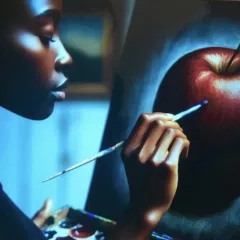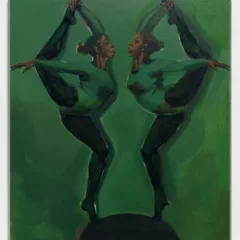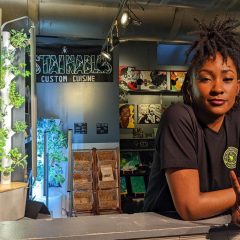Post by Andrea Kirsh
Our trusty correspondent Andrea Kirsh reports from Art Basel/Miami Beach, in four installments. Here’s the second.–r&l
Miami, December 7

The Chittendens, 2005, by Catherine Sullivan, © The artist
I was a bit too ambitious today (and, since ABMB forbade cameras, I made the mistake of leaving mine home today as well). In the morning I headed to the Rubell Family Collection, always an exciting place to visit. It’s 45,000 sq. ft. – that’s right, I didn’t add a zero – of contemporary art in a building just North of Miami’s downtown that was formerly a depository for guns confiscated by the feds. The previously-deserted neighborhood is rapidly being filled with expensive condos cheek-by-jowl with decrepit storage facilities that won’t survive. This year the Rubells showed work from California that they’d purchased during the past 18 months. They must have logged a lot of frequent flier points [lr: the images are of other pieces by some of the artists in the collection].
They acknowledged their debt to the controversial 1992 exhibition at L.A. MoCA, Helter Skelter (the title taken from Charles Manson), which introduced them to artists such as Charles Ray and Paul McCarthy, whom they’ve collected in depth. Sex was central to much of this work, in forms that cited everything from porn to Pre-Columbian ceramics.

Betty Ford, 2005, by Lara Schnitger, Wood, fabric, faux fur, pins, 91 x 86 x 62 inches, Courtesy Anton Kern Gallery, NY
The women looked particularly good. At the top of the stairs to the large, second-floor space was Lara Schnitger’s The Mothership, a looming construction of fabric stretched over a visible, wooden armature by means of elastic, with a playful nipple at the top. The room to the right was filled with Catherine Sullivan’s triple-screen video installation, and the walls were hung with stills from the same piece. In the next room was one of the largest drawings I’ve ever seen, by Violet Hopkins: a landscape as bizarre as anything Leonardo or Grunewald ever conceived, within a huge expanse of black (or blackened?) paper.
Downstairs the gallery opened directly onto the patio, sans glass or even screen – the easier to get out for a quick smoke, or enjoy the cream-cheese-and-guava-filled pastries the Rubells provided. And did I mention the crowds? Anyone who wanted to see art all day long was there, as Art Basel/Miami Beach doesn’t open until noon. The first friend I ran into was Eileen Rosenau, a colleague from Philadelphia who does public relations and is a great supporter of the arts. Then a former-Philadelphian: Mark Rosenthal, who lives in New York but gets to South Florida for his position as adjunct curator at the Norton Museum of Art in Palm Beach. Mark thought noone in Philadelphia would remember him, but I assured him otherwise. I had made a special point of going to Philadelphia from Miami in the mid ’80s to see the exhibition of Anselm Kiefer’s work that he organized at the PMA, knowing it would look much better there than in the underground galleries in MoMA, where it subsequently traveled.

Pot Head, Paul McCarthy, 2002, Pink Silicon Rubber, Steel, h: 33.5 x w: 42 x d: 48 in / h: 85.1 x w: 106.7 x d: 121.9 cm
When I told Mera Rubell that I enjoyed seeing Paul McCarthy’s homage to Robert Arneson in a large sculpture, Tripod, she said she hadn’t noticed the connection. I organized an exhibition of Arneson at the Lowe Art Museum in 1984, and think he still hasn’t gotten his due.

Everyday is Like Sunday, by T.R. Ericsson, at Ashley Gallery, Scope
Then I headed uptown a mile or so to Scope Miami, 90 dealers from 14 countries exhibiting in two huge, air-conditioned tents. They were set up in a neighborhood park surrounded by modest stucco bungalows which were decorated for Christmas as I remember from my Miami childhood, e.g. lights strung up on banana trees and papayas in fruit. I headed to Philadelphia’s Ashley Gallery, where I found one of their artists, T.R. Ericsson, whose work included marble plaques inscribed with poetry in minute lettering, as well as porcelain decorated with blue toile patterning. He was pleased with the number of visitors and the attention the gallery was getting.

Bimbo Ku Klux Klan by Boris Hoppek, at heliumcowboy artspace
Scope is a mix of well-known dealers (RICCO MARESCA and Annina Nosei of New York) with young galleries I’d never heard of. Among the later was heliumcowboy artspace (), the first gallery in Hamburg showing art that comes out of a graffiti aesthetic. As their literature states: art is not simply displayed but staged, amplified and created during the opening events. They were showing a group of small, stuffed figures by Boris Hoppek, which he calls Bimbos (cheap, at $100 each). These included White KKK Bimbo and Black KKK Bimbo; Hitler Bimbo had already been sold. I mentioned Space 1026 to Jorge Heikhause, the young director, as a place that would be sympathetic to their work.
I was foolish enough to attempt NADA as well, but I returned there Saturday (with my camera), so will save the comments for then.
–Artblog correspondent Andrea Kirsh is an art historian living in Philadelphia. See her Philadelphia Introductions essays on emerging artists at inliquid. Her most recent essay is on Stefan Abrams.









